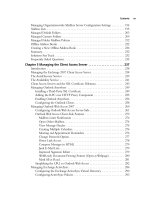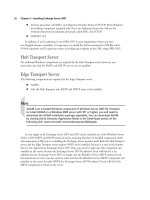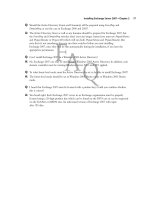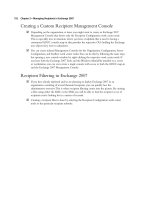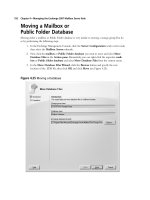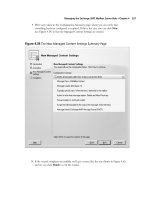Exchange SQL And IIS- P109 pot
Bạn đang xem bản rút gọn của tài liệu. Xem và tải ngay bản đầy đủ của tài liệu tại đây (298.78 KB, 5 trang )
High Availability for Exchange 2007 Mailbox Servers • Chapter 8 517
domain is shown in the From this location fi eld, as shown in Figure 8.40, and type
Cluster Service Account (or whatever name you gave the account in your setup).
click Check Names to verify that it resolves successfully. Click OK and close the
Computer Management MMC snap-in.
Figure 8.40 Adding the Cluster Service Account to the Local Administrators Group
5. Repeat Steps 1–4 for the server that will be the second node in the cluster.
Creating and Confi guring the Windows 2003
Server Cluster
Now that the two servers are ready to act as nodes in a Windows 2003 cluster, it’s time to create the
actual Windows 2003 Server Cluster. To do so:
1. Log onto EDFS07 with a domain admin account, then click Start | Administrative
Tools | Cluster Administrator, and select Create new cluster in the drop-down box.
Click OK and then click Next, as shown in Figure 8.41.
518 Chapter 8 • High Availability for Exchange 2007 Mailbox Servers
2. Now specify the domain name as well as the cluster name (the name for the Windows 2003
cluster, not the Exchange cluster name to which the clients will connect) as shown in
Figure 8.42, then click Next.
Figure 8.41 Creating a New Cluster
NOTE
You can also open a command prompt and type Cluster.exe /create /wizard to start
the Cluster Wizard.
High Availability for Exchange 2007 Mailbox Servers • Chapter 8 519
3. If it’s not already entered, type the name of the Windows 2003 server that is to be the fi rst
node in the cluster (in this case, EDFS07), then click Next (see Figure 8.43).
Figure 8.42 Specifying the Cluster Name and Domain
520 Chapter 8 • High Availability for Exchange 2007 Mailbox Servers
Figure 8.43 Adding the First Cluster Node to the New Cluster
4. Let the Cluster Wizard determine the cluster confi guration and click Next.
NOTE
You can ignore the two warnings shown in Figure 8.44, since the nodes in a cluster
continuous replication-based mailbox server setup aren’t going to share the same
disk subsystem.
High Availability for Exchange 2007 Mailbox Servers • Chapter 8 521
Figure 8.44 Analyzing Cluster Confi guration
5. Now enter the IP address that the cluster management tools should use to connect to the
cluster (in this case, 10.10.1.218) and click Next (see Figure 8.45).
